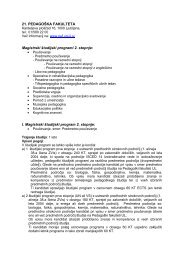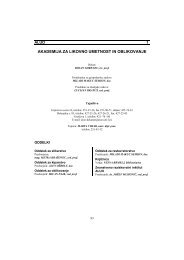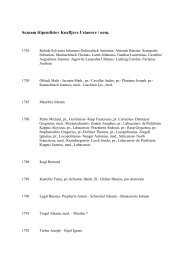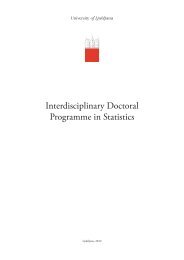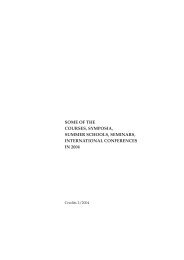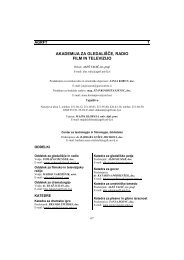Medicinska fakulteta Univerze v Ljubljani 1919–1945 - Univerza v ...
Medicinska fakulteta Univerze v Ljubljani 1919–1945 - Univerza v ...
Medicinska fakulteta Univerze v Ljubljani 1919–1945 - Univerza v ...
Create successful ePaper yourself
Turn your PDF publications into a flip-book with our unique Google optimized e-Paper software.
Ljubljana� Clarity about their organisation came only with the<br />
Rules on the Organisation and Discipline of Central Schools in<br />
Ljubljana as of 1 August 1810, which Janko Polecin and Fran<br />
Zwitter justifiably term the statutes of the French university in<br />
Ljubljana� The Rules distinguish between seven study courses<br />
(cours d’études), i�e� for doctors, surgeons, pharmacists, engineers,<br />
architects, land surveyors, lawyers and theologians� All study<br />
courses had an identical first-year programme with the same<br />
subjects: rhetoric (eloquence), metaphysics and physics� The<br />
entire study, including the mentioned first year, took five years<br />
for medical students and surgeons, four years for pharmacists,<br />
engineers, architects, lawyers and theologians and three years<br />
for land surveyors� The management of the central school was<br />
entrusted to a Regent (Rector) and a Chancellor (Secretary<br />
General)� The school was also supposed to have a library, a physics<br />
and chemistry laboratory and a botanical garden� The learning<br />
language was to be French or Italian and, if so required, this role<br />
could also be assumed by Latin� The provisions concerning the<br />
learning language stated that upon enrolment, students should be<br />
familiar with French, Italian and Latin grammar and rhetoric as<br />
well as logics and elementary mathematics�<br />
On 5 November 1810, the management of central schools (Rector<br />
Jožef Walland/Balant, Chancellor Matevž Ravnikar) called for<br />
enrolment and ten days later, the school ceremoniously opened<br />
its doors� In the first and only academic year of central schools of<br />
Ljubljana, the 1810-1811 academic year, 11 professors taught 301<br />
students of all faculties� In the first academic year of the academy,<br />
the 1811-1812 academic year, there were 313 students and in the<br />
next and final year of the academy, the 1812-1813 academic year,<br />
the number dropped to 273 students� At the time, 300 students<br />
was the average number for medium-sized universities, as only<br />
the largest universities had around 600 students� Vlado Schmidt<br />
emphasises that this clearly proves that “the French higher school<br />
(university) was appropriate and needed in Ljubljana�”<br />
The majority of new students (upon enrolment) were aged from<br />
18 to 19 years old, which is about a year older than the European<br />
average of the time� The average age of students at individual<br />
faculties was 17 for law, 18 for medicine, 19 for technology and<br />
20 for theology�<br />
Marmont’s arrangement of education – which briefly made<br />
Slovenian a taught subject and the learning language at the<br />
unified primary and lower secondary level and its permanent<br />
successor were Vodnik’s textbooks in Slovenian for the majority of<br />
subjects taught in primary and grammar schools – was distinctly<br />
temporary and was officially enforced only in the 1810-1811<br />
academic year� In line with the strict economisation ordered by<br />
Paris and the preparations for a gradual system integration with<br />
the French Empire, reforms were already being prepared by the<br />
end of the first school year� On 12 December 1811, Governor<br />
General of the Illyrian Provinces Count Henri-Gratien Bertrand<br />
signed a decree on the temporary regulation of Illyrian schools� A<br />
116<br />
number of previous educational institutions were abolished, for<br />
example some of the grammar schools which were not changed<br />
into colleges became ordinary primary schools that of course<br />
had to be maintained by municipalities� However, despite the<br />
reforms, Ljubljana kept its higher education study with ten chairs<br />
comprising the newly founded Ljubljana Academy (académie de<br />
Laybach)� Following the order of Count Bertrand, Zelli prepared<br />
detailed rules for the operation of colleges, private schools,<br />
lycées and “faculties of the academy of Illyrian Provinces”, which<br />
regulated the organisation of individual types of educational<br />
institutions� The “Rules for the Faculties of the Academy of<br />
Illyrian Provinces” foresaw the transformation of existing higher<br />
education courses in Ljubljana, which Marmont’s decree united<br />
into central schools, into a complete university in accordance<br />
with the existing French understanding of the word� The<br />
Academy of Illyrian Provinces with its headquarters in Ljubljana<br />
as the organisation for the entire education with an appointer<br />
Rector (recteur) and a ten-member Academy Council (conseil<br />
académique) comprised five faculties: the Faculty of Philosophy,<br />
of Technology, of Law and the Faculty of Medicine (with the<br />
Higher School of Pharmacy) under the management of Deans�<br />
In this respect, Janez Šumrada states that “in light of the statutes<br />
on the division of the French Imperial University as of 18<br />
October 1808, the Academy in Ljubljana was thus seen as being<br />
of the highest or first category, which is completely in line with<br />
the regulation of higher education in France at the time�” Illyrian<br />
authorities also sent the rules on the operation of educational<br />
institutions to Paris to be reviewed by the minister of the interior,<br />
who in turn required the opinion of the Grand Teacher and the<br />
University Council as well as the Office for Public Education<br />
run by the ministry� The Imperial University confirmed that<br />
the proposals of Illyrian authorities were in accordance with<br />
the French laws and that no reasons exist for them not to be<br />
confirmed� Janez Šumrada further states the opinion of the<br />
Imperial University that “until Illyrian Provinces are not subject<br />
to the same administrative forms as the remaining parts of the<br />
Empire, it will not intervene in the management and control of<br />
schools in Illyria�” On this basis, Janez Šumrada concludes that<br />
“this never happened: the academy, individual faculties and<br />
the lycée were never formally established� Lessons on higher<br />
secondary and on higher education level were much different<br />
than anticipated”, which individuals found already after the<br />
repeated Austrian assumption of power�<br />
III<br />
The rules on central schools, which Zelli signed on 1 August<br />
1819, left no doubts in terms of organisation� They clearly stated<br />
that central schools would be organised at faculty level and the<br />
Regent’s and Chancellor’s tasks, disciplinary rules for students,<br />
the duration of the academic year, holidays and exams were



